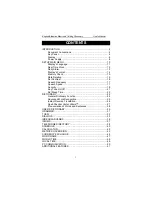
Cluster Group Overview
921
Cluster Group
Overview
The Cluster Group contains the parameters that
control the “clustering” characteristics of the
Generated Effect (the number of notes to generate
simultaneously each time a rhythm event occurs,
thereby creating chords and polyphonic phrases). Also
controlled from here is the degree of strumming on a
cluster, and the direction in which a cluster is
strummed.
About Cluster Patterns
A “cluster” is a group of notes that will be generated at
the same time, with a size ranging from 1 to 10. Cluster
Patterns control how many notes at a time will be
generated each time the Rhythm Pattern determines
that it is time to produce some notes (each “rhythm
event”). This can be used to cause chords to be
generated at certain times; the resulting chords may
optionally strummed or skewed in several ways, with
differing degrees of looseness. Random choices of
cluster sizes can be made from “Random Pools” of
values as described in detail later on.
If the Cluster Pattern is 1, then single notes are
produced (when “GE Type” (
0: Generated-
Riff
). A CMaj7 as input source material might
produced the following Riff:
If the Cluster Pattern was
{3, 1, 1, 3, 1, 2}
(and the Index
Pattern “Cluster Mode”
0: Single
following result would be produced by the same input
notes:
Note that the number of notes in a cluster can be
effectively doubled or quadrupled if “Invert,”
“Double” (
p.919) or both are being used in the Index
Group.
A Cluster Pattern will loop as long as note generation
continues. It normally will not reset to the beginning of
the Pattern unless a new Trigger is received, or unless
the Phase Pattern has been configured to restart it at
the beginning of certain Phases. This means that a four
step Rhythm Pattern can be looping while an eight
step Velocity Pattern and a twelve step Cluster Pattern
are also independently looping, for example.
Strum
[0…1000 (ms)]
Sets the value in milliseconds that each cluster will be
“strummed” (quickly arpeggiated or flammed). Note
that a single note cannot be strummed, so this only has
an effect on cluster sizes greater than 1. This is the total
time for each cluster, so each note in a cluster of 5 notes
will be closer together than a cluster of 3 notes with the
same strum value. This maintains a proper degree of
“looseness” while changing cluster sizes.
Strums are presently alternated in the up and down
direction. By setting this to high values (so there are
not really strums, but arpeggiations happening),
interesting overlappings of each cluster over
subsequent clusters can be made to occur.
Not available if “GE Type” (
2:
Generated-Drum
. Not available if “GE Type” =
1:
Generated-Gated
and “Gate Type” =
Expression
.
Pattern Grid & Associated Parameters
Cluster Pattern
A Cluster Pattern represents a series of values
indicating the size of clusters of notes to be generated
(chords). It has any number of steps up to 32, with each
step being represented by one column on the grid. The
first column always contains at least one value; unused
columns appear disabled. The 10 rows represent the
number of notes to be generated at a time, from 1 to 10.
Pattern grids cannot be viewed or edited on the
OASYS.
Input
1
1
1
1
1
1
1
Cluster Pattern [1]
etc.
Input
3
1
1
3
1
2
3 etc.
Cluster Pattern
{3, 1, 1, 3, 1, 2}
Summary of Contents for Electronic Keyboard
Page 1: ...Parameter Guide Parameter Guide ...
Page 2: ......
Page 180: ...Program mode EXi 170 ...
Page 290: ...EXi STR 1 Plucked String 280 ...
Page 572: ...Sequencer mode 562 ...
Page 700: ...Global mode 690 ...
Page 751: ...Insert Effects IFX1 IFX12 Routing 741 Fig 2 3a Fig 2 3b ...
Page 902: ...Effect Guide 892 ...
















































